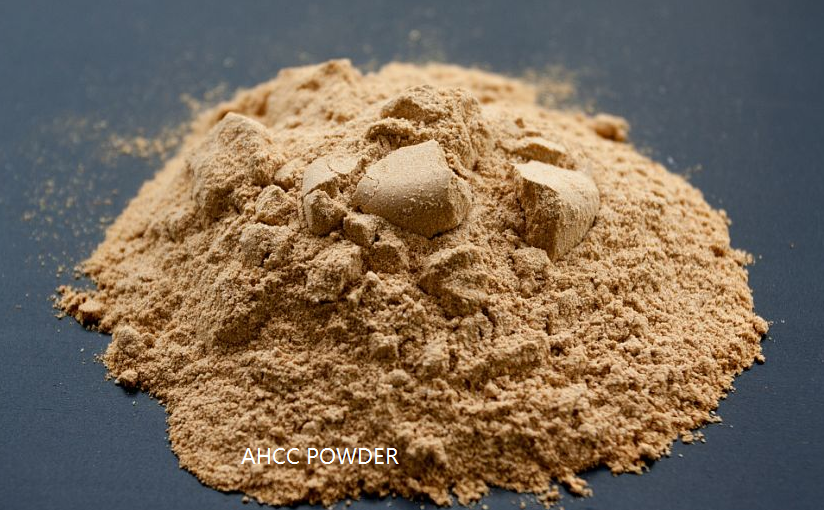Contact Us
For Product Pricing, Customization, Or Other Inquiries:
Contact Supplier
Call Us
Active hexose correlated compound, AHCC
AHCC is primarily available as a capsule. Manufacturer dosing guidelines recommend two 500 mg capsules orally 3 times a day on an empty stomach, or 2 capsules orally daily for general well-being. Dosages up to 6 g/day have been used.
Contraindications
Avoid use in individuals hypersensitive to any of the components of AHCC or to basidiomycete mushrooms.

Pregnancy/Lactation
Information regarding safety and efficacy in pregnancy and lactation is lacking.
Interactions
Use with caution in patients taking aromatase inhibitors and medications metabolized via cytochrome P450 (CYP-450) 2D6.
Adverse Reactions
A phase 1 trial reported mild GI complaints, including nausea, diarrhea, and bloating. Some patients also reported headache, fatigue, and foot cramps with the liquid form of AHCC. AHCC is generally well tolerated.
Toxicology
In a phase 1 trial, AHCC 9 g/day for 14 days had minimal adverse effects and was well tolerated by most patients.
Source
AHCC is an extract prepared from mycelia of several species of basidiomycete mushrooms, including shiitake or Lentinula edodes, after being cultured in a liquid medium.Kenner 2001, Kenner 2001, Kidd 2000
History
AHCC was developed in 1987 at the University of Tokyo Faculty of Pharmaceutical Sciences, along with other researchers, as a natural product for use in regulating high blood pressure. However, AHCC is now primarily known for its immunostimulant potential in protecting against viruses, cancers, and infections.Kenner 2001, Kidd 2000 AHCC is being researched in the United States, China, Korea, Japan, and Thailand. Its use as a nutritional supplement is most common in Japan and the United States.Belay 2015 AHCC has been used as a supplement for patients with cancer, HIV/AIDS, hepatitis C, hypertension, and autoimmune diseases. There are also anecdotal claims of use in treating wounds, stomach ulcers, gum disease, fatigue syndrome, parasites, and multiple sclerosis.Kenner 2001, Pescatore 2008
Chemistry
AHCC is obtained by a patented process involving cultivation, enzymatic decomposition, sterilization, concentration, and freeze drying.Kenner 2001 It contains carbohydrates (mainly polysaccharides), small amounts of protein, amino acids, lipids, and minerals.Fujii 2011, Kenner 2001, Kidd 2000, Ritz 2006, Yanagimoto 2016 The enzyme-fermented compound is an extract of the mycelia of basidiomycete mushrooms. Oligosaccharides account for nearly 74% of AHCC, and approximately 20% of these saccharides are partially acetylated alpha-1,4-glucans with a mean molecular weight of 5,000 Daltons.Aviles 2008, Pescatore 2008 The hydroxyl groups of C-2 and/or C-3 positions on the alpha-1,4-glucans are partially acylated.Yanagimoto 2016 AHCC contains less than 0.2% of beta-glucans, and the alpha-glucans have much better oral absorption.Mathew 2017 The biological activities of AHCC are associated with the acetylated forms of the low-molecular-weight oligosaccharides.Aviles 2008, Kidd 2000, Pescatore 2008
Uses and Pharmacology
The medical literature documents the use of AHCC as an immunomodulatory agent, as well as efficacy as an adjuvant in cancer treatment and various infections.
Cancer
AHCC is thought to modulate tumor immune surveillance by regulating innate and adaptive immune system responses. The compound may act as a biological response modifier by enhancing natural killer cell activity, interleukin 12 (IL-12) and tumor immunity production, and spleen cell proliferation and cytokine production.Gao 2006
Contraindications
Avoid use in individuals hypersensitive to any of the components of AHCC or to basidiomycete mushrooms.

Pregnancy/Lactation
Information regarding safety and efficacy in pregnancy and lactation is lacking.
Interactions
Use with caution in patients taking aromatase inhibitors and medications metabolized via cytochrome P450 (CYP-450) 2D6.
Adverse Reactions
A phase 1 trial reported mild GI complaints, including nausea, diarrhea, and bloating. Some patients also reported headache, fatigue, and foot cramps with the liquid form of AHCC. AHCC is generally well tolerated.
Toxicology
In a phase 1 trial, AHCC 9 g/day for 14 days had minimal adverse effects and was well tolerated by most patients.
Source
AHCC is an extract prepared from mycelia of several species of basidiomycete mushrooms, including shiitake or Lentinula edodes, after being cultured in a liquid medium.Kenner 2001, Kenner 2001, Kidd 2000
History
AHCC was developed in 1987 at the University of Tokyo Faculty of Pharmaceutical Sciences, along with other researchers, as a natural product for use in regulating high blood pressure. However, AHCC is now primarily known for its immunostimulant potential in protecting against viruses, cancers, and infections.Kenner 2001, Kidd 2000 AHCC is being researched in the United States, China, Korea, Japan, and Thailand. Its use as a nutritional supplement is most common in Japan and the United States.Belay 2015 AHCC has been used as a supplement for patients with cancer, HIV/AIDS, hepatitis C, hypertension, and autoimmune diseases. There are also anecdotal claims of use in treating wounds, stomach ulcers, gum disease, fatigue syndrome, parasites, and multiple sclerosis.Kenner 2001, Pescatore 2008
Chemistry
AHCC is obtained by a patented process involving cultivation, enzymatic decomposition, sterilization, concentration, and freeze drying.Kenner 2001 It contains carbohydrates (mainly polysaccharides), small amounts of protein, amino acids, lipids, and minerals.Fujii 2011, Kenner 2001, Kidd 2000, Ritz 2006, Yanagimoto 2016 The enzyme-fermented compound is an extract of the mycelia of basidiomycete mushrooms. Oligosaccharides account for nearly 74% of AHCC, and approximately 20% of these saccharides are partially acetylated alpha-1,4-glucans with a mean molecular weight of 5,000 Daltons.Aviles 2008, Pescatore 2008 The hydroxyl groups of C-2 and/or C-3 positions on the alpha-1,4-glucans are partially acylated.Yanagimoto 2016 AHCC contains less than 0.2% of beta-glucans, and the alpha-glucans have much better oral absorption.Mathew 2017 The biological activities of AHCC are associated with the acetylated forms of the low-molecular-weight oligosaccharides.Aviles 2008, Kidd 2000, Pescatore 2008
Uses and Pharmacology
The medical literature documents the use of AHCC as an immunomodulatory agent, as well as efficacy as an adjuvant in cancer treatment and various infections.
Cancer
AHCC is thought to modulate tumor immune surveillance by regulating innate and adaptive immune system responses. The compound may act as a biological response modifier by enhancing natural killer cell activity, interleukin 12 (IL-12) and tumor immunity production, and spleen cell proliferation and cytokine production.Gao 2006






